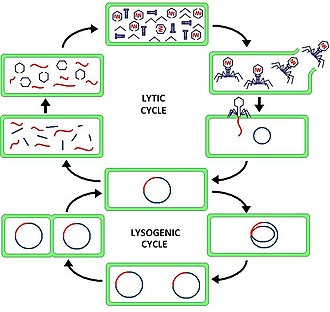Temperateness (virology)
Temperateness (Virology)[edit]

In the field of virology, temperateness refers to a specific type of interaction between a bacteriophage and its bacterial host. A temperate phage is capable of entering a lysogenic cycle, where it integrates its genetic material into the host's genome and replicates along with it, rather than immediately lysing the host cell. This behavior contrasts with that of a virulent phage, which only follows the lytic cycle, leading to the destruction of the host cell.
Lysogenic Cycle[edit]
In the lysogenic cycle, the temperate phage's DNA is incorporated into the host bacterium's chromosome, becoming a prophage. This integration is facilitated by specific enzymes that allow the phage DNA to recombine with the bacterial DNA. Once integrated, the prophage is passively replicated along with the host cell's DNA during cell division. This allows the phage to persist in the host population without causing immediate harm.
The lysogenic cycle can be advantageous for the phage, as it allows the viral genome to be maintained in a stable environment, potentially for many generations. Environmental factors, such as UV light or certain chemicals, can trigger the prophage to excise itself from the host genome and enter the lytic cycle, leading to the production of new phage particles and the eventual lysis of the host cell.
Lytic Cycle[edit]
The lytic cycle is the alternative pathway that a temperate phage can follow. In this cycle, the phage takes over the host cell's machinery to produce new phage particles. This process involves the degradation of the host DNA, replication of the phage genome, and assembly of new phage particles. Eventually, the host cell is lysed, releasing the newly formed phages to infect other cells.
Advantages of Temperateness[edit]
Temperateness provides several evolutionary advantages to phages:
- Survival in Host Populations: By integrating into the host genome, temperate phages can persist in host populations even when conditions are not favorable for lytic replication.
- Genetic Exchange: The lysogenic cycle allows for horizontal gene transfer between bacteria, as prophages can carry genes from one host to another, contributing to genetic diversity and evolution.
- Adaptation to Environmental Changes: The ability to switch between lysogenic and lytic cycles allows temperate phages to adapt to changing environmental conditions, optimizing their survival and propagation.
Related Pages[edit]
Ad. Transform your life with W8MD's Budget GLP-1 injections from $75


W8MD offers a medical weight loss program to lose weight in Philadelphia. Our physician-supervised medical weight loss provides:
- Weight loss injections in NYC (generic and brand names):
- Zepbound / Mounjaro, Wegovy / Ozempic, Saxenda
- Most insurances accepted or discounted self-pay rates. We will obtain insurance prior authorizations if needed.
- Generic GLP1 weight loss injections from $75 for the starting dose.
- Also offer prescription weight loss medications including Phentermine, Qsymia, Diethylpropion, Contrave etc.
NYC weight loss doctor appointmentsNYC weight loss doctor appointments
Start your NYC weight loss journey today at our NYC medical weight loss and Philadelphia medical weight loss clinics.
- Call 718-946-5500 to lose weight in NYC or for medical weight loss in Philadelphia 215-676-2334.
- Tags:NYC medical weight loss, Philadelphia lose weight Zepbound NYC, Budget GLP1 weight loss injections, Wegovy Philadelphia, Wegovy NYC, Philadelphia medical weight loss, Brookly weight loss and Wegovy NYC
|
WikiMD's Wellness Encyclopedia |
| Let Food Be Thy Medicine Medicine Thy Food - Hippocrates |
Medical Disclaimer: WikiMD is not a substitute for professional medical advice. The information on WikiMD is provided as an information resource only, may be incorrect, outdated or misleading, and is not to be used or relied on for any diagnostic or treatment purposes. Please consult your health care provider before making any healthcare decisions or for guidance about a specific medical condition. WikiMD expressly disclaims responsibility, and shall have no liability, for any damages, loss, injury, or liability whatsoever suffered as a result of your reliance on the information contained in this site. By visiting this site you agree to the foregoing terms and conditions, which may from time to time be changed or supplemented by WikiMD. If you do not agree to the foregoing terms and conditions, you should not enter or use this site. See full disclaimer.
Credits:Most images are courtesy of Wikimedia commons, and templates, categories Wikipedia, licensed under CC BY SA or similar.
Translate this page: - East Asian
中文,
日本,
한국어,
South Asian
हिन्दी,
தமிழ்,
తెలుగు,
Urdu,
ಕನ್ನಡ,
Southeast Asian
Indonesian,
Vietnamese,
Thai,
မြန်မာဘာသာ,
বাংলা
European
español,
Deutsch,
français,
Greek,
português do Brasil,
polski,
română,
русский,
Nederlands,
norsk,
svenska,
suomi,
Italian
Middle Eastern & African
عربى,
Turkish,
Persian,
Hebrew,
Afrikaans,
isiZulu,
Kiswahili,
Other
Bulgarian,
Hungarian,
Czech,
Swedish,
മലയാളം,
मराठी,
ਪੰਜਾਬੀ,
ગુજરાતી,
Portuguese,
Ukrainian